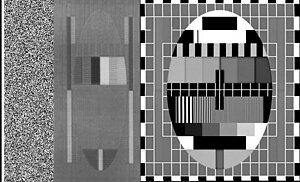Technical details
MAC transmits luminance and chrominance data separately in time rather than separately in frequency (as other analog television formats do, such as composite video). B-MAC uses teletext-style non-return-to-zero (NRZ) signaling with a capacity of 1.625 Mbit/s. The video and audio/data signals are therefore combined at baseband.
For audio, a format similar to NICAM was transmitted digitally rather than as an FM subcarrier.
The MAC standard included a standard scrambling system, EuroCrypt, a precursor to the standard DVB-CSA encryption system.
In MAC color is encoded using the YPbPr color space. [5] Luma ( ) is derived from red, green, and blue (
) is derived from red, green, and blue ( ) after gamma-correction (formula similar to PAL):
) after gamma-correction (formula similar to PAL):  [5]
[5]
Chrominance is computed based on  and
and  differences, generating two compressed and weighted color-difference signals,
differences, generating two compressed and weighted color-difference signals,  and
and  . [5]
. [5]
The  signal range is between -0.5 and 0.5 volts while
signal range is between -0.5 and 0.5 volts while  and
and  signals vary between -0.65 to 0.65 volts.
signals vary between -0.65 to 0.65 volts.
The following table lists the main technical parameters of B-MAC variants: [5] [6]
This page is based on this
Wikipedia article Text is available under the
CC BY-SA 4.0 license; additional terms may apply.
Images, videos and audio are available under their respective licenses.













